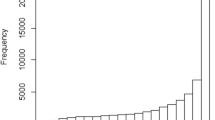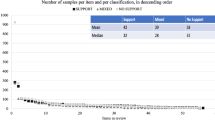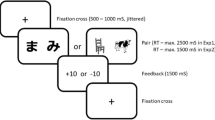Abstract
Stimulus generalization and contextual control affect the development of equivalence classes. Experiment 1 demonstrated primary stimulus generalization from the members of trained equivalence classes. Adults were taught to match six spoken Icelandic nouns and corresponding printed words and pictures to one another in computerized three-choice matching-to-sample tasks. Tests confirmed that six equivalence classes had formed. Without further training, plural forms of the stimuli were presented in tests for all matching performances. All participants demonstrated virtually errorless performances. In Experiment 2, classifications of the nouns used in Experiment 1 were brought under contextual control. Three nouns were feminine and three were masculine. The match-to-sample training taught participants to select a comparison of the same number as the sample (i.e., singular or plural) in the presence of contextual stimulus A regardless of noun gender. Concurrently, in the presence of contextual stimulus B, participants were taught to select a comparison of the same gender as the sample (i.e., feminine or masculine), regardless of number. Generalization was assessed using a card-sorting test. All participants eventually sorted the cards correctly into gender and number stimulus classes. When printed words used in training were replaced by their picture equivalents, participants demonstrated almost errorless performances.
Similar content being viewed by others
References
Adams, B. J., Fields, L., & Verhave, T. (1993). Formation of generalized equivalence classes. The Psychological Record, 43, 553–566.
Barnes, D., & Keenan, M. (1993). A transfer of functions through derived arbitrary and nonarbitrary stimulus relations. Journal of the Experimental Analysis of Behavior, 59, 61–81.
Berko, J. (1958). The child’s learning of English morphology. Word, 14, 150–177.
Bush, K. M., Sidman, M., & de Rose, T. (1989). Contextual control of emergent equivalence relations. Journal of the Experimental Analysis of Behavior, 51, 29–45.
Catania, A. C. (1992). Learning (3rd ed.). Englewood Cliffs, NJ: Prentice Hall.
Cowley, B. J., Green, G., & Braunling-McMorrow, D. (1992). Using stimulus equivalence procedures to teach name-face matching to adults with brain injuries. Journal of Applied Behavior Analysis, 25, 461–475.
Dale, R. (2004). Cognitive and behavioral approaches to language acquisition: Conceptual and empirical intersections. The Behavior Analyst Today, 5, 336–359.
Dale, R., Roche, J., & Duran, N. (2008). Language is complex. International Journal of Psychology and Psychological Therapy, 8, 351–362.
Dube, W. V. (1991). Computer software for stimulus control research with Macintosh computers. Experimental Analysis of Human Behavior Bulletin, 9, 28–30.
Dube, W. V., & Mcllvane, W. J. (1996). Some implications of a stimulus control topography analysis for emergent behaviour and stimulus classes. In T. R. Zentall & P. M. Smeets (Eds.), Stimulus class formation in humans and animals (pp. 197–218). Amsterdam: Elsevier Science B.V.
Fields, L., Reeve, K. F., Adams, B. J., Brown, J. L., & Verhave, T. (1997). Predicting the extension of equivalence classes from primary generalization gradients: The merger of equivalence classes and perceptual classes. Journal of the Experimental Analysis of Behavior, 68, 67–91.
Fields, L., Reeve, K. F., Adams, B. J., & Verhave, T. (1991). Stimulus generalization and equivalence classes: A model for natural categories. Journal of the Experimental Analysis of Behavior, 55, 305–312.
Galizio, M., Stewart, K. L., & Pilgrim, C. (2004). Tipicality effects in contingency-shaped generalized equivalence classes. Journal of the Experimental Analysis of Behavior, 82, 253–273.
Gatch, M. B., & Osborne, J. G. (1989). Transfer of contextual stimulus function via equivalence class development. Journal of the Experimental Analysis of Behavior, 51, 369–378.
Green, G, Sigurdardóttir, Z. G., & Saunders, R. R. (1991). The role of instructions in the transfer of ordinal functions through equivalence classes. Journal of the Experimental Analysis of Behavior, 55, 287–304.
Griffée, K., & Dougher, M. J. (2002). Contextual control of stimulus generalization and stimulus equivalence in hierarchical categorization. Journal of the Experimental Analysis of Behavior, 78, 433–447.
Gruendel, J. M. (1977). Referential extension in early language development. Child Development, 48, 1567–1576.
Hayes, S., Kohlenberg, B. S., & Hayes, L. (1991). The transfer of specific and general consequential functions through simple and conditional equivalence relations. Journal of the Experimental Analysis of Behavior, 56, 119–137.
Houmanfar, R., Hayes, L. J., & Herbst, S. A. (2005). An analog study of first language dominance and interference over second language. The Analysis of Verbal Behavior, 21, 75–98.
Kohlenberg, B. S., Hayes, S., & Hayes, L. (1991). The transfer of contextual control over equivalence classes through equivalence classes: A possible model of social stereotyping. Journal of the Experimental Analysis of Behavior, 56, 505–518.
Lane, S. D., Clow, J. K., Innis, A., & Critchfield, T. (1998). Generalization of cross-modal stimulus equivalence classes: Operant processes as components in human category formation. Journal of the Experimental Analysis of Behavior, 70, 267–279.
Lazar, R. M., & Kotlarchyk, B. J. (1986). Second-order control of sequence-class equivalences in children. Behavioral Processes, 13, 205–215.
Lowe, C. F., Home, P. J., Harris, F. D. A., Randle, V. R. L. (2002). Naming and categorization in young children: vocal tact training. Journal of the Experimental Analysis of Behavior, 78, 527–549.
Lynch, D. C., & Green, G. (1991). Development and crossmodal transfer of contextual control of emergent stimulus relations. Journal of the Experimental Analysis of Behavior, 56, 139–154.
Mackay, H. A. (1991). Stimulus equivalence: Implications for the development of adaptive behavior. In R. Remington (Ed.), The challenge of severe mental handicap: An applied behaviour analytic approach (pp. 235–259). London, England: John Wiley & Sons.
Mackay, H. A., & Fields, L. (2009). Syntax, grammatical transformation, and productivity: A synthesis of stimulus sequences, equivalence classes and contextual control. In R. A. Rehfeldt & Y. Barnes-Holmes (Eds.), Derived relational responding: Applications for learners with autism and other developmental disabilities: A progressive guide for change. Oakland, CA: New Harbinger.
Mackay, H. A., Wilkinson, K. M., Farrell, C., & Serna, R. W. (2011). Evaluating merger and intersection of equivalence classes with one member in common. Journal of the Experimental Analysis of Behavior, 96, 87–105.
Mcllvane, W. J., Dube, W. V., Green, G., & Serna, R. W. (1993). Programming conceptual and communication skill development: A methodological stimulus class analysis. In A. P. Kaiser & D. B. Gray (Eds.), Enhancing children’s communication: Research foundations for intervention. (pp. 243–285). Baltimore: Paul H. Brookes.
Pérez-González, L. A., & Serna, R. W. (2003). An analysis of generalized contextual control of conditional discriminations. Journal of the Experimental Analysis of Behavior, 79, 395–408.
Pilgrim, C., & Galizio, M. (1996). A class of correlations or a correlation of classes. In T. R. Zentall, & P. M. Smeets (Eds.), Stimulus class formation in humans and animals (pp. 173–197). Amsterdam: Elsevier.
Salzinger, K. (2008). Skinner’s Verbal behavior. Journal of Psychology and Psychological Therapy, 8, 287–294.
Saunders, R. R., Saunders, K. J., Kirby, K. C., & Spradlin, J. E. (1988). The merger and development of equivalence classes by unreinforced conditional selection of comparison stimuli. Journal of the Experimental Analysis of Behavior, 50, 145–162.
Saunders, R. R., Wachter, J., & Spradlin, J. E. (1988). Establishing auditory stimulus control over an eight-member equivalence class via conditional discrimination procedures. Journal of the Experimental Analysis of Behavior, 49, 95–115.
Serna, R. W., & Pérez-González, L. A. (2003). Transfer of specific contextual functions to novel conditional discriminations. Journal of the Experimental Analysis of Behavior, 79, 383–393.
Sidman, M. (1971). Reading and auditory-visual equivalences. Journal of Speech and Hearing Research, 14, 5–13.
Sidman, M. (1986). Functional analysis of emergent verbal classes. In T. Thompson & M. D. Zeiler (Eds.), Analysis and integration of behavioral units (pp. 213–245). Hillsdale, NJ: Erlbaum.
Sidman, M. (1994). Equivalence relations and behavior: A research story. Boston: Authors Cooperative.
Sidman, M., Rauzin, R., Lazar, R., Cunningham, S., Tailby, W., & Carrigan, P. (1982). A search for symmetry in the conditional discriminations of rhesus monkeys, baboons, and children. Journal of the Experimental Analysis of Behavior, 37, 23–44.
Sidman, M., & Tailby, W. (1982). Conditional discrimination vs. matching to sample: An expansion of the testing paradigm. Journal of the Experimental Analysis of Behavior, 37, 5–22.
Sidman, M., Wynne, C. K., Maguire, R. W., & Barnes, T. (1989). Functional classes and equivalence relations. Journal of the Experimental Analysis of Behavior, 52, 261–274.
Sigurdardóttir, Z. G., Green, G., & Saunders, R. R. (1990). Equivalence classes generated by sequence training. Journal of the Experimental Analysis of Behavior, 53, 47–63.
Skinner, B. F. (1957). Verbal behavior. Englewood Cliffs, NJ: Prentice-Hall.
Stemmer, N. (1990). Skinner’s Verbal Behavior, Chomsky’s review, and mentalism. Journal of the Experimental Analysis of Behavior, 54, 307–315.
Thomson, J. R., & Chapman, R. S. (1977). Who is “Daddy” revisited: the status of two-year-olds’ over-extended words in use and comprehension. Journal of Child Language, 4, 359–375.
Washio, Y., & Houmanfar, R. (2007). Role of contextual control in second language performance. The Analysis of Verbal Behavior, 23, 41–56.
Author information
Authors and Affiliations
Corresponding author
Rights and permissions
About this article
Cite this article
Sigurðardóttir, Z.G., Mackay, H.A. & Green, G. Stimulus Equivalence, Generalization, and Contextual Stimulus Control in Verbal Classes. Analysis Verbal Behav 28, 3–29 (2012). https://doi.org/10.1007/BF03393105
Published:
Issue Date:
DOI: https://doi.org/10.1007/BF03393105




